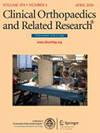What Factors Are Associated With Acute Compartment Syndrome After Gunshot Injuries to the Upper Extremity?
IF 4.4
2区 医学
Q1 ORTHOPEDICS
引用次数: 0
Abstract
BACKGROUND Firearm-related injuries are a growing cause of morbidity and mortality in the United States, with varying odds of acute compartment syndrome (ACS) and other complications reported in the research. ACS is associated with higher complications after injury, including infection, need for repeat surgery, and functional loss, with the forearm being one of the most common sites for ACS. Although ACS in gunshot-related injuries has been studied, existing research documents wildly variable odds of developing ACS, with much of these data derived from military sources with high-energy weapons or inclusive of upper and lower extremity injuries. QUESTIONS/PURPOSES (1) What proportion of patients with upper extremity gunshot wounds (GSWs) experienced ACS? (2) Which patient- or injury-related factors, such as vascular injury, are associated with the development of ACS? (3) What postoperative complications are associated with ACS after gunshot injuries? METHODS Between May 2018 and January 2023, we treated 1740 patients with GSWs presenting to a single, urban Level 1 trauma center. After excluding lower limb and torso injuries, 773 patients with upper extremity injuries were identified, of which 42 left hospital care prior to assessment and therefore had no data for analysis, leaving 731 for inclusion. As part of our institutional standard, GSWs are trauma activations with a recommended 12 to 24 hours of observation followed by discharge with strict and specific return precautions and education on the signs and symptoms of compartment syndrome. Patient demographics, injury characteristics, and outcomes were collected through reviews of the electronic medical record (EMR) and a longitudinally maintained trauma database, which reflects a combination of 60% blunt and 40% ballistic injuries. Institutionally, the population with GSWs is predominantly male (90%), with a mean age of 32 years and injuries to the torso, pelvis and acetabulum, and the long bones, as well as periarticular fractures. Identification of patients with ACS was performed using the institutional trauma database followed by a search of the EMR for relevant Current Procedural Terminology codes and clinical documentation of gunshot injury and compartment syndrome, followed by manual chart review that specifically included patients without signs of ACS to capture those at risk, even if they did not go on to surgery. Univariate analysis was conducted to identify associations with ACS. RESULTS In patients with gunshot injuries to the upper extremity, we found that 2% (12 of 731) developed ACS, with all subsequent surgically treated patients undergoing forearm fasciotomy. Vascular injury was the only factor associated with the development of ACS OR 47 [95% confidence interval (CI) 12 to 181]; p < 0.001). Other variables, including fracture location and polytrauma, were not associated with the development of ACS. Patients who developed ACS had a high risk of persistent postoperative neurologic deficits (50% [6 of 12] of patients) compared with those without ACS, and patients with ACS had higher odds of having persistent neurologic deficits (OR 4.25 [95% CI 1 to 18]; p = 0.01). CONCLUSION Evaluation of a large group of patients with upper extremity GSWs demonstrated that at least 2% developed ACS. Although higher odds of ACS may occur, the protocols and monitoring observed in this study reduce but do not eliminate the risk that ACS development is higher. This study demonstrated that vascular injury has a strong independent association with ACS, regardless of fracture presence or injury location, and a high level of suspicion for ACS in these patients is warranted. While the overall risk of ACS in patients with upper extremity GSWs is small, the outcomes of missed ACS are severe, and close monitoring as well as discharge precautions outlining signs and symptoms necessitating return to the emergency department are recommended. Further research is warranted to improve early detection strategies, such as specialized imaging, remote monitoring, or standardized observation protocols. LEVEL OF EVIDENCE Level III, prognostic study.上肢枪伤后急性筋膜室综合征与哪些因素相关?
背景:在美国,枪支相关伤害是发病率和死亡率不断上升的原因,研究中报道了急性间室综合征(ACS)和其他并发症的不同几率。ACS与损伤后较高的并发症相关,包括感染、需要重复手术和功能丧失,前臂是ACS最常见的部位之一。尽管已经对枪击相关损伤中的ACS进行了研究,但现有的研究表明,发生ACS的几率差异很大,其中大部分数据来自使用高能武器的军事来源或包括上肢和下肢损伤。问题/目的(1)上肢枪伤(GSWs)患者发生ACS的比例是多少?(2)哪些患者或损伤相关因素(如血管损伤)与ACS的发生有关?(3)枪伤后ACS的术后并发症有哪些?方法:2018年5月至2023年1月,我们治疗了1740例在单一城市一级创伤中心就诊的GSWs患者。在排除下肢和躯干损伤后,确定了773例上肢损伤患者,其中42例在评估前离开了医院护理,因此没有数据可供分析,剩下731例纳入。作为我们机构标准的一部分,GSWs是创伤激活,建议观察12到24小时,然后出院,有严格和具体的预防措施,并对隔室综合征的体征和症状进行教育。通过审查电子病历(EMR)和纵向维护的创伤数据库收集患者人口统计数据、损伤特征和结果,该数据库反映了60%的钝性损伤和40%的弹道损伤。从制度上看,GSWs患者主要为男性(90%),平均年龄32岁,躯干、骨盆、髋臼、长骨以及关节周围骨折均有损伤。识别ACS患者使用机构创伤数据库,然后搜索EMR相关的当前程序术语代码和枪伤和筋膜间室综合征的临床文件,然后进行手工图表审查,特别是包括没有ACS迹象的患者,以捕捉那些有风险的患者,即使他们不进行手术。进行单因素分析以确定与ACS的相关性。结果在731例上肢枪伤患者中,我们发现2%(12 / 731)发生ACS,所有后续手术治疗的患者均行前臂筋膜切开术。血管损伤是ACS发生的唯一相关因素[95%可信区间(CI) 12 ~ 181];P < 0.001)。其他变量,包括骨折位置和多发伤,与ACS的发展无关。与未发生ACS的患者相比,发生ACS的患者术后出现持续性神经功能缺损的风险较高(50%[12 / 6]例患者),且ACS患者出现持续性神经功能缺损的几率更高(OR 4.25 [95% CI 1 ~ 18]; p = 0.01)。结论对大量上肢GSWs患者的评估表明,至少2%的患者发展为ACS。虽然可能发生ACS的几率较高,但本研究中观察到的方案和监测降低了但不能消除ACS发展较高的风险。该研究表明,血管损伤与ACS有很强的独立相关性,无论骨折是否存在或损伤位置如何,这些患者对ACS的高度怀疑是有根据的。虽然上肢GSWs患者发生ACS的总体风险很小,但漏诊ACS的结果很严重,因此建议密切监测并制定出院预防措施,列出需要返回急诊室的体征和症状。有必要进一步研究以改进早期检测策略,如专门成像、远程监测或标准化观察方案。证据等级:III级,预后研究。
本文章由计算机程序翻译,如有差异,请以英文原文为准。
求助全文
约1分钟内获得全文
求助全文
来源期刊
CiteScore
7.00
自引率
11.90%
发文量
722
审稿时长
2.5 months
期刊介绍:
Clinical Orthopaedics and Related Research® is a leading peer-reviewed journal devoted to the dissemination of new and important orthopaedic knowledge.
CORR® brings readers the latest clinical and basic research, along with columns, commentaries, and interviews with authors.

 求助内容:
求助内容: 应助结果提醒方式:
应助结果提醒方式:


